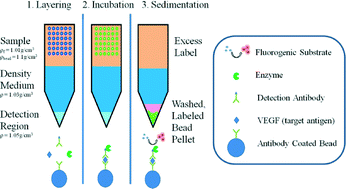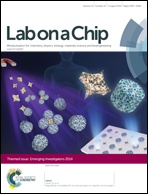A centrifugal fluidic immunoassay for ocular diagnostics with an enzymatically hydrolyzed fluorogenic substrate
Abstract
We present a novel “Lab-on-a-Disk” platform and demonstrate its capability for rapid and sensitive measurement of vascular endothelial growth factor (VEGF) intended for patients suffering from diabetic retinopathy (DR) and age-related macular degeneration (AMD). This approach combines sedimentation principles applied to microspheres under centrifugal force with signal amplification using an enzyme and a fluorogenic substrate for readout. The simple single channel per assay platform separates, washes and concentrates antibody-coated microspheres from excess label to produce a sensitive fluorogenic response proportional to the amount of VEGF in the sample. This platform has comparable sensitivity to conventional ELISA and can generate a readout within 16–18 min with no sample preparation beyond mixing assay reagents and loading on the disk. In the context of ocular diagnostics, this device has the potential to facilitate accurate dosing of anti-VEGF medications utilized to treat DR and AMD, as well as identify patients whose ocular VEGF levels are not elevated and who would therefore not benefit from standard anti-VEGF medications.

- This article is part of the themed collection: 2014 Lab on a Chip Emerging Investigators

 Please wait while we load your content...
Please wait while we load your content...